The long sought resting place of Genghis Khan might be finally discovered, using space based technology. The grave of the great conqueror may be found by crowdsourcing satellite data.

The location of the tomb of Genghis Khan has been the object of much speculation and research. The site remains undiscovered to this day. The Khan asked to be buried without any disctinctive markings and made extraordinary efforts that his tomb not be found. According to the gruesome legend, the funeral escort killed anyone and anything that crossed their path, in order to conceal where he was finally buried. After the tomb was completed, the slaves who built it were massacred, and then the soldiers who killed them were also killed.
It’s clear that Genghis Khan wanted to avoid his grave being robbed, but I’m not sure he’d be ok with modern archaeologists finding his burial place either. Albert Yu-Min Lin, from the University of California, San Diego, set up a creative project asking anyone interested to tag potential sites of the burial through images taken from space. This allowed researchers to access manpower they couldn’t otherwise afford, and it also allowed people to get involved in valuable archaeological study.
“Over 10K online volunteers contributed 30K hours (3.4 years), examined 6,000 km2, and generated 2.3 million feature categorisations,” the study said.
This is not the most efficient approach, it’s a lot like looking for the needle in the hay stack… but it’s pretty much the only thing left.
Discussing its success, the study said: “We charged an online crowd of volunteer participants with the challenge of finding the tomb of Genghis Khan, an archaeological enigma of unknown characteristics widely believed to be hidden somewhere within the range of our satellite imagery. This is a needle in a haystack problem where the appearance of the needle is unknown.”
The result is a map with 55 archaeological sites across a “vast landscape”, with the locations ranging from the Bronze Age to the Mongol period of origin. It’s not clear if Genghis Khan’s grave is among those, but either way, it’s a significant and valuable find. Speaking to National Geographic, Lin said:
“Using traditional archaeological methods would be disrespectful to believers. The ability to explore in a noninvasive way lets us try to solve this ancient secret without overstepping cultural barriers. It also allows us to empower Mongolian researchers with tools they might not have access to otherwise.
Even though today, the Khan is regarded as a cruel and ruthless leader, there is no denying his achievements – and there were also some upsides to his ruthless conquest.
“Today’s world still benefits from Genghis Kahn’s ability to connect East with West. He forged international relations that have never been broken. By locating his tomb, we hope to emphasise how important it is for the world to protect such cultural heritage treasures.”
Journal Reference: Albert Yu-Min Lin, Andrew Huynh, Gert Lanckriet, Luke Barrington. Crowdsourcing the Unknown: The Satellite Search for Genghis Khan. Published: December 30, 2014DOI: 10.1371/journal.pone.0114046






